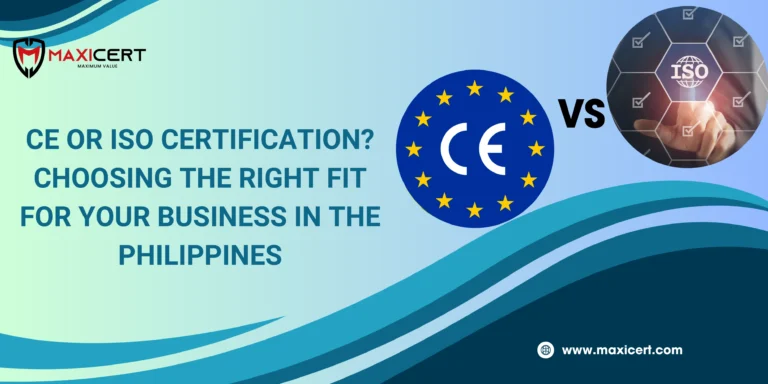CE vs ISO Certification? Choosing the Right Fit for Your Business in the Philippines

Introduction
As Philippine businesses reach worldwide markets or seek enhanced operational credibility locally, one important question often surfaces: Do we need CE Certification, ISO Certification—or both?
At first glance, CE and ISO certifications might appear similar. But they serve very different purposes. One focuses on product safety and market access, the other on operational excellence and consistency.
In this guide, we’ll break down the core differences between CE and ISO, when each is necessary, and how Philippine businesses can navigate compliance smoothly.
What is CE Certification?
CE is short for Conformité Européenne, or “European Conformity” in French. The CE mark means that a product is in conformity with European Union (EU) health, safety, and environmental protection rules.
CE marking is obligatory for most products sold in the European Economic Area (EEA), such as:
- Electrical and electronic equipment
- Medical devices
- Toys and machinery
- Construction products
For Filipino manufacturers and exporters who are shipping to EU countries, CE certification is usually not optional—it’s a statutory obligation.
Request A Free Quote
What is ISO Certification and Why Is It Important?
Unlike CE, ISO certification isn’t product-specific legal compliance. It’s about how an organization works—its processes, risk controls, customer focus, and quality management systems.
ISO certification is awarded by third-party accredited bodies and is employed across the world to exhibit credibility, efficiency, and consistency.
Common ISO Standards in the Philippines:
- ISO 9001 – Quality Management
- ISO 14001 – Environmental Management
- ISO 45001 – Occupational Health and Safety
- ISO 22000 – Food Safety Management
Read more about our ISO certification services in the Philippines
ISO is voluntary, although many businesses seek it to be able to access bigger clients, improve internal control, or be eligible for tenders.
CE vs ISO Philippines: What's the Difference?
| Criteria | CE Certification | ISO Certification |
|---|---|---|
| 1. Purpose | Ensures products meet EU laws on safety, health, and environmental protection. | Ensures business processes follow global standards for quality, management, and efficiency. |
| 2. Scope | Applies to physical products only. | Applies to organizations across all industries and services. |
| 3. Legality | Legally required in the EU for certain products. | Voluntary, but often requested by clients, partners, or regulators. |
| 4. Certification Bodies | Certified through EU Notified Bodies for high-risk items. | Certified by accredited ISO bodies like Maxicert. |
Which Certification Do You Need in the Philippines?
Your business model, objectives, and markets determine the appropriate certification. Let’s consider a couple of examples:
If You Export to Europe
If you produce goods such as electronics, industrial equipment, or medical equipment for EU buyers, you need to have CE marking.
But here’s the twist: a lot of European buyers also want suppliers to possess ISO certifications—notably ISO 9001 for quality management.
Best Solution:
- Obtain CE to be EU law-compliant
- Obtain ISO to enhance buyer trust and internalize processes
You Cater Domestic or ASEAN Markets
If you’re not exporting to Europe, CE is probably not applicable. But ISO certification is still essential if you intend to tender for contracts, enhance internal processes, or establish customer confidence.
Sectors such as construction, healthcare, logistics, and manufacturing in the Philippines increasingly prefer vendors who are ISO-certified.
Best Approach:
- Emphasize the applicable ISO standard in your sector (e.g., ISO 14001 for construction, ISO 22000 for food)
- Avoid CE unless your target market is the EU
If You Want to Expand Globally
For global expansion ambitions, it makes sense to go for both CE and ISO—if you produce products and intend to sell on various continents.
Best Approach:
- Get both CE (for opening up product sales) and ISO (for credibility and internal improvement)
How to Get CE or ISO Certified in the Philippines
Let’s explain the process for each:
CE Certification Process:
- Identify applicable EU directive(s)
- Perform product risk assessment and testing
- Cooperate with a Notified Body (if necessary)
- Prepare a Technical File
- Execute the Declaration of Conformity
- Apply the CE Mark to your product
CE testing laboratories and Notified Body coordination may be arranged through global partners or EU-based certifiers.
ISO Certification Process:
- Select the ISO standard (e.g., ISO 9001, ISO 45001)
- Gap analysis and internal audit
- Implement the management system
- Carry out training and documentation
- Submit to third-party audit by a certifying body
- Get your ISO certificate
Discover how we assist Philippine companies in becoming ISO certified
Key Benefits of CE and ISO Certification
Whether separately or together, CE and ISO certifications deliver measurable advantages for Philippine businesses:
Benefits of CE Certification
Enables access to EU markets
Improves product design and safety assurance
Reduces the risk of import bans or customs rejection
Builds confidence with European buyers and regulators
Benefits of ISO Certification
Boosts operational efficiency and quality control
Helps win tenders, contracts, and new clients
Enhances your business reputation in the local and global market
Encourages a culture of continuous improvement internally
Common Mistakes Philippine Companies Make with CE or ISO Certification
Many businesses in the Philippines make similar mistakes when trying to get certified. Avoiding these can save time, money, and stress.
1. Mixing Up CE and ISO
Some companies think CE and ISO mean the same thing. But they don’t. CE is for making sure your product is safe to sell in the EU. ISO is about improving how your business runs. Confusing the two can slow things down.
2. Not Checking If You’re Ready
Trying to get certified without checking your current setup is risky. You need to do a gap check first—this helps you fix what’s missing before applying.
3. Choosing the Wrong ISO Standard
Businesses sometimes go for ISO 9001 just because it’s common. But every industry has its own ISO standard. For example, food companies need ISO 22000. Picking the wrong one may not help your goals.
4. Thinking CE is Optional
If you want to sell your product in Europe, CE marking is often required by law. Skipping it could lead to your product being blocked at customs.
5. Working with the Wrong Certifier
Some companies use non-accredited bodies, which offer cheap but invalid certificates. Always check if your certifier is officially recognized—especially for CE (via EU Notified Bodies) and ISO.
6. Poor Documentation
Both CE and ISO need proper documents—like manuals, procedures, and records. Many fail audits because they don’t take this seriously.
Why Maxicert for CE and ISO Certification in the Philippines?
With Maxicert, we make certification easy for expanding Philippine companies.
- Local presence, global connections
- Clear timelines and documentation support
- Assistance from pre-audit to complete certification
- Affordable for SMEs, exporters, and manufacturers
- Trusted by businesses in construction, food, healthcare, and technology
Whether you require CE for exports to the EU or ISO for domestic contracts, we provide complete support with no delay or confusion.
Conclusion
If you’re exporting to the EU, CE certification is a must. For local credibility and stronger internal systems, ISO is the better fit. Businesses aiming for global reach should consider both. Each serves a unique purpose, but together, they provide a solid path to compliance and growth.
Not sure which one suits your business? Our experts can help you decide and guide you through the process. Book your free consultation today for fast support, expert advice, and cost-effective solutions.

Get In Touch

Get In Touch

Get In Touch
Need A Free Estimate?
Get a free consultation and Checklist to get certified for ISO , HALAL, CE Mark Certification.
FAQ
Can a company get CE and ISO certified simultaneously?
Yes. Numerous exporters are ISO 9001 certified and possess CE marks for specific goods.
Is CE Certification mandatory in the Philippines?
Only when exporting to the EU. It is not a Philippine regulation requirement for domestic sales.
What are the most widely used ISO standards for Philippine companies?
ISO 9001 (Quality), ISO 14001 (Environment), ISO 45001 (Occupational Health & Safety) and ISO 22000 (Food Safety)
How much time do CE and ISO certifications take?
CE: 1–3 months (product complexity dependent) and ISO: 3–6 months (depending on the current state of readiness)



